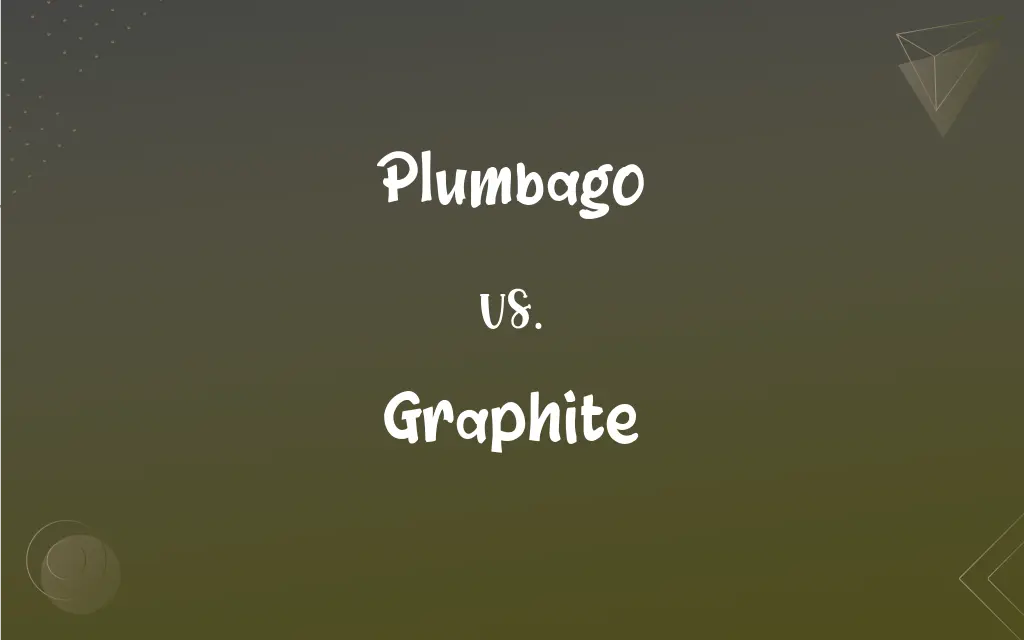Plumbago vs. Graphite: What's the Difference?
By Aimie Carlson & Harlon Moss || Updated on May 30, 2024
Plumbago and graphite are terms for the same mineral form of carbon; plumbago is an older term, while graphite is the modern term commonly used today.

Key Differences
Plumbago, also known as black lead, is an older term historically used to refer to what we now commonly call graphite. This term is rarely used today except in historical contexts. Graphite is the modern term for the naturally occurring form of crystalline carbon. It is widely used today in pencils, batteries, lubricants, and as a moderator in nuclear reactors. The name graphite, derived from the Greek word "graphein," meaning "to write," reflects its primary use in writing instruments.
Plumbago was historically significant in the development of the pencil industry, being the primary material for pencil "leads." Graphite continues this legacy but has expanded its applications due to its unique properties, such as high conductivity and heat resistance.
Both plumbago and graphite exhibit similar physical properties, such as a greasy feel and metallic luster. However, graphite's recognition in scientific and industrial contexts has led to its broader use in modern technology, while plumbago remains a term of historical interest.
In terms of chemical composition, both plumbago and graphite consist of carbon atoms arranged in a hexagonal lattice. This structure gives graphite its characteristic properties, such as excellent electrical conductivity and high thermal resistance.
Comparison Chart
Definition
Historical term for graphite
Modern term for crystalline carbon form
ADVERTISEMENT
Usage
Historically in pencils, lubrication
Pencils, batteries, lubricants, and more
Name Origin
Derived from Latin "plumbum" (lead)
Derived from Greek "graphein" (to write)
Recognition
Mostly historical context
Widely used in scientific/industrial fields
Physical Properties
Greasy feel, metallic luster
Greasy feel, metallic luster
Plumbago and Graphite Definitions
Plumbago
Historical term for graphite.
The artist used plumbago to sketch the initial drawing.
ADVERTISEMENT
Graphite
Modern term for crystalline form of carbon.
Graphite is used in the production of batteries.
Plumbago
Material historically significant in writing tools.
Plumbago's use in pencils dates back to the 16th century.
Graphite
Commonly used in pencils today.
The core of a pencil is made of graphite.
Plumbago
Carbon mineral used in early lubricants.
Plumbago was applied to machinery parts to reduce friction.
Graphite
Material with high thermal resistance.
Graphite is utilized in high-temperature industrial applications.
Plumbago
See graphite.
Graphite
Used as a moderator in nuclear reactors.
Graphite slows down neutrons in nuclear reactors.
Plumbago
See leadwort.
Graphite
A soft crystalline allotrope of carbon, composed of graphene layers, having a steel-gray to black metallic luster and a greasy feel, used in lead pencils, lubricants, paints and coatings, and fabricated into a variety of forms such as molds, bricks, electrodes, crucibles, and rocket nozzles. Also called black lead, plumbago.
Plumbago
(botany) A plant of the genus Plumbago; leadwort.
Graphite
An allotrope of carbon, consisting of planes of carbon atoms arranged in hexagonal arrays with the planes stacked loosely, that is used as a dry lubricant, in "lead" pencils, and as a moderator in some nuclear reactors.
Plumbago
Graphite.
Graphite
Short for graphite-reinforced plastic, a composite plastic made with graphite fibers noted for light weight strength and stiffness.
Modern tennis racquets are made of graphite, fibreglass and other man-made materials.
Plumbago
Same as Graphite.
Graphite
A grey colour, resembling graphite or the marks made with a graphite pencil.
Plumbago
A genus of herbaceous plants with pretty salver-shaped corollas, usually blue or violet; leadwort.
Graphite
(transitive) To apply graphite to.
Plumbago
Used as a lubricant and as a moderator in nuclear reactors
Graphite
Native carbon in hexagonal crystals, also foliated or granular massive, of black color and metallic luster, and so soft as to leave a trace on paper. It is used for pencils (improperly called lead pencils), for crucibles, and as a lubricator, etc. Often called plumbago or black lead.
Plumbago
Any plumbaginaceous plant of the genus Plumbago
Graphite
Used as a lubricant and as a moderator in nuclear reactors
Plumbago
Also known as black lead.
Plumbago was once mined extensively for use in pencils.
Graphite
Known for its excellent electrical conductivity.
Graphite is used in electrodes for electric arc furnaces.
Plumbago
Substance with metallic luster and greasy feel.
Plumbago leaves a mark similar to lead on paper.
FAQs
Are plumbago and graphite the same?
Yes, they refer to the same mineral, but plumbago is an older term.
What is plumbago?
Plumbago is an older term historically used to refer to graphite.
What are modern uses of graphite?
Graphite is used in pencils, batteries, lubricants, and nuclear reactors.
What is graphite?
Graphite is the modern term for the naturally occurring form of crystalline carbon.
Why is graphite used in pencils?
Graphite can leave marks on paper, making it ideal for writing and drawing.
Is plumbago found in nature?
Yes, plumbago (graphite) is a naturally occurring mineral.
What is the origin of the name graphite?
Graphite comes from the Greek word "graphein," meaning to write.
What was plumbago used for?
Plumbago was used in pencils, lubrication, and other early applications.
Can graphite withstand high temperatures?
Yes, graphite has high thermal resistance and is used in high-temperature applications.
Is graphite the same as coal?
No, graphite and coal are different forms of carbon with distinct properties.
What role does graphite play in nuclear reactors?
Graphite acts as a moderator to slow down neutrons in nuclear reactors.
What is the origin of the name plumbago?
Plumbago comes from the Latin word "plumbum," meaning lead.
How is graphite mined?
Graphite is mined through both open-pit and underground mining methods.
Can graphite be synthetic?
Yes, synthetic graphite is produced for various industrial applications.
Is plumbago still used today?
The term plumbago is rarely used today except in historical contexts.
Why does graphite have a greasy feel?
Graphite has a layered structure that allows the layers to slide over each other, giving it a greasy feel.
What industries use graphite?
Graphite is used in industries such as electronics, metallurgy, and nuclear energy.
Was plumbago used in early pencils?
Yes, plumbago was the primary material used in early pencil manufacturing.
Does graphite conduct electricity?
Yes, graphite is an excellent conductor of electricity.
Why is graphite used in batteries?
Graphite's conductive properties make it suitable for use in batteries.
About Author
Written by
Aimie CarlsonAimie Carlson, holding a master's degree in English literature, is a fervent English language enthusiast. She lends her writing talents to Difference Wiki, a prominent website that specializes in comparisons, offering readers insightful analyses that both captivate and inform.
Co-written by
Harlon MossHarlon is a seasoned quality moderator and accomplished content writer for Difference Wiki. An alumnus of the prestigious University of California, he earned his degree in Computer Science. Leveraging his academic background, Harlon brings a meticulous and informed perspective to his work, ensuring content accuracy and excellence.
































































